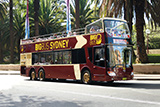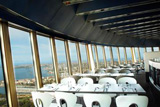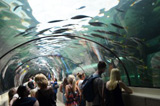
sydney.com.au
Est 1994, Sydney's oldest tourism website


|
|
SYDNEY WALKS


The walk begins at the car park at Bradleys Head. Picture: © Sydney.com.au
Bradleys Head to Chowder Bay walk
takes you through the national park
BRADLEYS HEAD TO CHOWDER BAY WALK
Distance: 2.8km one way
Time to walk: 1.5 to 2.5 hours
Starting point: Bradleys Head car park
Finish: Clifton Gardens beach car park
Refreshments break: Athol Hall, 200 metres from path (signposted);
Ripples restaurant and cafe, Chowder Bay
Return options: 244 bus service to city from Chowder Bay Road
The walk from Bradleys Head around Taylor's Bay to Chowder Bay through the Sydney Harbour National Park is the second of three walks along the northern foreshores from Taronga Zoo to Balmoral Beach.
This is a walk that immerses you completely in the national park and is the least walked of the three Mosman harbourside walks. In winter months you can wander along much of the path without encountering people. At certain times of the day it's popular with runners and you have to keep a watch out. Unfortunately most of the people who run here will not slow down and are determined not to go around you, which means you have to step aside.
This is a walk that is also more in tune with nature, reflected in the changing plant life as you get further into the walk and the number of bird species. There are 150 bird species in the national park, including the white-bellied sea eagle and New Holland honeyeater.
Frog concertos can be heard at different points along the walk. The odd bush turkey pops up from time to time and doesn't seem at all concerned about sharing the path with humans. This is a walk where you feel very much removed from the city.
You get occasional glimpses of the water along the way, but not to the same degree as the other two walks. That's largely because the walking path is enclosed with dense vegetation for much of the way and also because after leaving the point at Bradleys Head, you are following the foreshores of Taylors Bay away from the harbour. For much of the way the only water views you get are glimpses of Taylors Bay. If you look at a map, you will notice that you are also skirting around the back of Taronga Zoo (although some distance away).
Following the winding foreshores on this particular harbourside walk, you don't realise at first how much you are walking back on yourself. For instance, after about a third of the way into the walk, a sign pops up pointing to Athol Hall, some 200 metres away. If you look back at the first walk (Taronga Zoo wharf to Bradeley Head), you will see that Athol Hall appears a short distance after starting that walk.
Speaking of Athol Hall, if you're in need of a short refreshments break there's a cafe at the hall where you can have lunch or coffee on the verandah with panoramic views of Sydney Harbour.
In the final stages of the walk the path leads directly below houses built on the cliffs overlooking Taylors Bay. Many of these houses are huge - some almost overwheming - and they seem at odds with the forest and Taylors Bay.
The walk eventually winds its way up around Chowder Head before descending into the car park at Clifton Gardens beach in Chowder Bay. The name "Chowder Bay" is thought to refer to American whalers visiting the bay in the 1800s and their practice of making chowder from the shellfish in the bay.
The sight was chosen for the establishment of the Royal Australian Navy's Submarine Miners' Depot in the 1890s, after which a cable with mines attached was laid from the bay to the other side of Sydney Harbour. The mining depot was decommissioned in 1922 and the base and buildings retained for military use. Today, large timber buildings still remain but are now put to other use.
Chowder Bay was opened to the public in 2000 following decades of military occupation.
If you walk to the end of the Clifton Gardens beach, a path leads up above the former military buildings to a roundabout and roadway where you can catch a 244 bus in Chowder Bay Road to the city via Mosman.
If, on the other hand, you feel like lunch or coffee before catching a bus or walking back, Ripples restaurant and cafe is situated in one of the former naval buildings. From there you can look out on Chowder Bay and the harbour.


The Bradleys Head lighthouse is seen as you begin the walk.
Picture: © Sydney.com.au



Above: The Sydney Harbour Bridge can still be seen from Bradleys Head. Above right: A white Australian flag flies from the mast of HMAS Sydney, a landmark at the reserve. The light cruiser was decommissioned in 1929 and its mast erected at Bradleys Head in 1934 as a war monument. pictures: © Sydney.com.au


The first part of the walking path leading away from Bradleys Head comprises a memorial avenue of 22 trees and plaques, opened in 2014, commemorating Royal Australian Navy ships and submarines lost in war. Picture: © Sydney.com.au


Each plaque commemorates a ship or submarine sunk during war time. This one commemorates HMAS Geelong, which sank after a collison with a US tanker in New Guinea in 1944. Picture: © Sydney.com.au


Another plaque commemorates HMAS Kuttabul, which was sunk by a Japanese midget submarine in Sydney Harbour in 1942. Picture: © Sydney.com.au


A signpost takes you away from the road and onto a bushwalking path.
Picture: © Sydney.com.au


The path becomes narrower and the vegetation thickens.
Picture: © Sydney.com.au


A harbour view pops up as Bradeys Head is left behind. Picture: © Sydney.com.au


The seemingly pristine waters of Taylors Bay. Picture: © Sydney.com.au


Harbour views give way to ferns and gums trees. Picture: © Sydney.com.au


Small lush ferns add a blaze of colour to the walk. Picture: © Sydney.com.au


A clearing appears and a ferry can be seen making its way to Manly.
Picture: © Sydney.com.au


The path narrows and the vegetation grows denser. Picture: © Sydney.com.au


Nearing Chowder Bay, large houses can be seen on the point ahead.
Picture: © Sydney.com.au


The walk gets steeper and stone steps suddenly appear.
Picture: © Sydney.com.au


The serenity of Taylors Bay is a far cry from the bustle of Sydney Harbour.
Picture: © Sydney.com.au


The path is suddenly overgrown with rainforest-type plants.
Picture: © Sydney.com.au


Stone steps become more common. Picture: © Sydney.com.au


Peep holes appear that provide glimpses of picturesque small coves.
Picture: © Sydney.com.au


With the path winding along the foreshore below houses, boardwalks replace stone steps. Picture: © Sydney.com.au


A partly constructed house the size of a small shopping complex rises above the walking path.
Picture: © Sydney.com.au


Stone steps lead up from the path to the houses above. Picture: © Sydney.com.au







